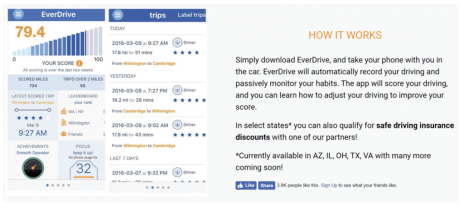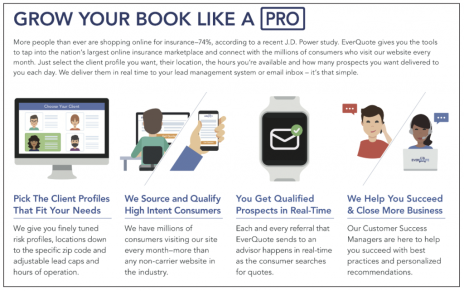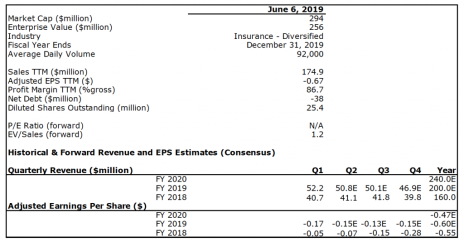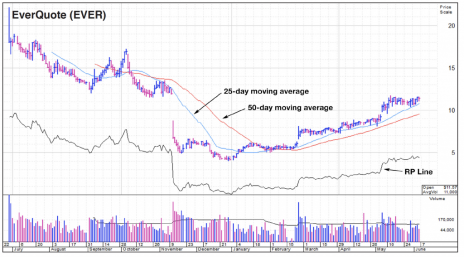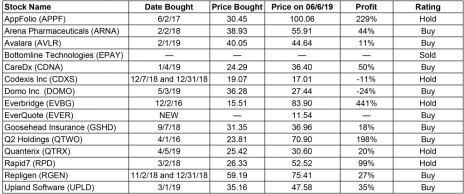Today’s Cabot Small-Cap Confidential candidate runs an online marketplace for a different type of market where over $120 billion is spent each year. The trend is strong, and it’s still early days. All the details are inside the June Issue of Cabot Small-Cap Confidential.
Cabot Small Cap Confidential 241
[premium_html_toc post_id="178983"]
THE BIG IDEA
On a whim, I recently reviewed our car insurance.
Something didn’t feel right, so I went online and got a quote from another provider. It turns out they could cover our two cars with essentially the same coverage – for half the price.
I was floored. How the heck could this be? Isn’t car insurance a relatively standardized, commodity-type product?
No!
Turns out different carriers have great products for certain demographics in certain states, and horrible ones for others. We were with the wrong car insurance carrier for our profile.
Without getting into the weeds of the situation, the basic deal is that insurance is a competitive and heavily regulated industry. Rules vary by state. There are different actuarial standards, statutory requirements, types and levels of coverage, bundles and discounts available depending on where you live. Other factors, such as age, model of car, etc. play a role too.
Because there are so many variables insurance carriers build and target products for certain types of consumers in different markets. If you’re not in the target group for a given insurance provider for a given insurance product, you’re likely getting a raw deal.
All this variability makes shopping and comparing insurance products a pain in the neck for consumers.
I can tell you from recent experience.
There are hundreds of carriers to choose from, making apples-to-apples comparisons on pricing and coverage options challenging. This leads many consumers to just stick with what they have, even though they could literally be burning cash every month.
On the insurance provider side of the equation it’s not all high fives and keg stands either. Despite huge advances in online marketing technologies it’s still very challenging for individual carriers to efficiently target advertising dollars only at those consumers who match their products’ perfect risk profile.
This leads to huge sums of inefficiently spent money. Industry data shows insurance providers are spending $123 billion a year on non-health insurance sales, marketing and distribution activities. Around $115 billion of this goes to agent commissions, while the remaining $8 billion goes toward advertising.
Whenever there is a big misalignment in a huge market there is an opportunity for a technology platform that bridges the gap, reduces friction, and generally makes life easier and less expensive for everyone involved.
In the insurance industry, as in the travel industry, the solution is an online shopping marketplace. A platform that lets consumers compare products and have the confidence to click “buy,” even without speaking with an agent.
The trend is moving in this direction. But there’s still a lot of room to move insurance purchases online. Around 70% of consumers shop for insurance online now, but 80% of policies are still closed offline through insurance agents.
I expect the number of people shopping for insurance online will continue to go up, while the percentage of policies closed through agents will come down. People are buying cars, renting houses, banking and getting advice from doctors online. We’re all going to be buying insurance online soon too.
An online marketplace that matches insurance buyers with sellers is a simple concept with big potential. Here’s the story of the company that’s leading the charge.
THE COMPANY
EverQuote (EVER) offers an online shopping place where consumers can compare and buy insurance policies. The company was started in 2011, went public in 2018 and now has a market cap of $290 million. With over 11 million consumer visits per month, EverQuote operates the largest online marketplace for insurance shopping in the United States.
The company is working to bring insurance shopping into the digital age, much like what has been done in the travel, hotel and house booking, and car rental markets. It began by just offering auto insurance. Then, in 2016, EverQuote launched home and life insurance. This year it plans to launch three new verticals; renters’, health and commercial insurance.
Management’s vision is to make it easy for consumers to find and buy the right insurance for their needs and budget. And to save both customers and insurance providers time and money by streamlining the shopping and purchasing process via the EverQuote.com online marketplace.
It appears to be succeeding. Consumer surveys suggest people that have purchased auto insurance through EverQuote.com save $556 a year on their policies. With roughly 5.3 million auto insurance policies sourced through EverQuote to date that works out to total consumer savings of nearly $3 billion!
While we’re still early in the shift to online insurance shopping, the trend is unmistakable, which is why insurance carriers continue to integrate their marketing efforts with EverQuote and pay the company for referrals.
Those referrals are how the company makes money. And it’s been doing well. Revenue growth has averaged 27% over the last five years and is expected to top 20% in both 2019 and 2020. First-quarter 2019 revenue was up 28%, to $52.2 million.
Historically, growth has come from selling auto insurance referrals to insurance carriers and agents. Going forward auto insurance will remain a big part of the business, but a good chunk of future growth will likely come from new products.
Auto insurance grew by 25% to $45 million in Q1 (86% of total revenue). But home and life insurance, both of which launched in 2016, grew at a 50% clip to $7.2 million (14% of revenue).
We don’t yet know what the impact of EverQuote’s expansion into renters’, health and commercial insurance will be. But if history is any guide it could be significant. Over the last three years quotes for home insurance have risen seven-fold and quotes for life insurance are up five-fold. Open enrollment for health insurance is in Q4 of the year, so EverQuote should have that vertical up and running just in time.
EverQuote’s platform currently features over 160 insurance carriers, including the top 20 property and casualty carriers by premium volume. The two largest customers (28% of revenue in 2018) are Progressive and GEICO.
One of the bullish trends is that direct revenue from insurance carriers, which are stable, high-paying customers, has grown from 8% in 2012 to 80% in 2017, and to 90% in 2018.
While not contributing as much to revenue, insurance agents represent an important customer base too since this is how 80% of policies are currently closed. Plus, there are roughly 100,000 agents out there. EverQuote has around 7,500 agents on the EverQuote Pro platform. It’s also beginning to add financial advisors (there are about 300,000 of them out there), which represent a relaively new customer base given that EverQuote only recently launched its life insurance vertical.
THE PRODUCT
EverQuote’s platform is all about data science. It’s built on proprietary algorithms that are designed to efficiently pull in consumers, match them with the best insurance providers, and generate valuable referrals that insurance carriers, agents and financial advisors will pay top dollar for.
Like most data-rich assets, the value of EverQuote’s platform and algorithms grows as the ecosystem and network expands. This general process goes like this:
First, EverQuote engages consumers through its EverQuote.com website, EverDrive safe-driving mobile app, or, to a lesser extent, offline through a network of call centers and verified partners. Online customers submit a quote request based on entering 20 to 50 data points, which then connects them to relevant insurance providers.
Behind the scenes insurance carriers, agents and financial advisers use their own web-based portals to participate in a unified, real-time auction that matches consumers with them based on referral bid price, consumer profile and other factors.
Consumers are then handed off to the carrier, agent or financial adviser and can purchase the desired insurance policy, either online or offline.
Consumer Products & Services
EverQuote is essentially a middleman that aims to match consumers with the right insurance carrier or agent. There are three ways it accomplishes this:
EverQuote.com
This is the company’s primary digital property and where consumers shop online for insurance quotes. Consumers visit the website and enter their information and the type of insurance they want quoted. The website is integrated with many insurance providers’ systems, which streamlines workflows, and generates faster, more accurate quotes for consumers. That increases conversion rates and data quality for insurance providers.
The trend is strong. As of the end of January 2019 EverQuote.com has generated over 47 million auto, home and life insurance quotes (including 12.8 million in 2018), and helped consumers purchase roughly 5.3 million policies. Management says that on a daily basis it gets around 240,000 website hits and 34,000 quote requests.
Inbound Calls and Verified Partner Network
In 2019 EverQuote began matching consumers with insurance providers (based on consumer zip code) through inbound calls that consumers made to EverQuote call center partners. The company also started acquiring quote requests from third-party vendors that were part of its verified partner network. These sources of consumer interest help generate policies from a broader group of consumers that did not visit the EverQuote.com website. This is a new initiative that we’ll hear more about in upcoming conference calls.
EverDrive
EverDrive is a free safe-driving mobile app that gives consumers in-depth info about their driving behavior, including harsh braking, speeding and distracted phone use. It has a social media aspect that lets users compare their driving habits against friends and other EverDrive community members. Users can decide if and how they want to share data with insurance carriers. If data is shared, carriers gain access to a pre-qualified group of drivers and can offer them significant discounts on auto insurance.
EverDrive is a new solution that management is rolling out gradually. Over half a million users have downloaded the app so far. And in Q1 the number of states where it’s available grew from five to 12. The company is hiring to grow the EverDrive team, which suggests it could represent a material source of referrals down the road.
Insurance Provider Products & Services
Insurance providers and agents look to EverQuote as a source of motivated consumers that are a good match for the insurance products they offer. There are several ways EverQuote is becoming an important and efficient consumer acquisition and retention channel for its customers.
EverQuote Pro for Carriers
Insurance carriers use this web-based marketplace to manage campaigns to meet their desired scale and ROI. They can target consumers based on attributes such as geography, demographics, behavioral characteristics and coverage needs.
EverQuote Pro for Agents
Agents use their own version of the EverQuote Pro marketplace to purchase referrals. The self-service platform allows agents to select their desired consumer profiles, geographic areas, budgets, and insurance product types.
SmartCampaigns
SmartCampaigns gives participating insurance carriers an automated solution to acquire policies that match their ROI targets without having to manage campaigns independently in the EverQuote Pro marketplace.
Seamless Consumer Handoff (i.e. Carrier Integrations)
One of the key value propositions of EverQuote’s platform is that it can reduce friction and make it easier for consumers to buy insurance online. A big way to accomplish this is to integrate data from the EverQuote platform with insurance carriers’ workflows.
The company offers two options: (1) prefill, in which consumers only need to confirm data they’ve already provided, and (2) full click-to-quote integration, which removes all intermediate steps and gives the consumer a quote as soon as it lands on an insurance providers website.
Full integrations have been shown to increase conversion rates by 11% to 41%, and that’s leading carriers to gain confidence in EverQuote as an important source of customer referrals. In Q1 2019 management reported that seven out of its top 10 carriers increased spending on the platform. It also completed six new integrations and expanded 14 partial integrations. Now, its top 10 customers all have at least a partial integration.
The Business Model
EverQuote generates revenue by selling referrals to insurance carriers, insurance agents, financial advisors and, to a very limited extent, indirect distributors/aggregators. The company builds its user base of consumers primarily through online advertising. And it builds its insurance carrier, agent and financial advisor customer base through a 70-person sales organization, as well as through email, search, social media, and content marketing.
The business grows (or shrinks) based on a continuous, positive (or negative) feedback loop. As consumer traffic on its platform grows, EverQuote collects more data, which leads to more quote requests, which improves the ROI of customers on the platform. That, in turn, allows EverQuote to spend more to attract more customers, resulting in more data fed into the platform. In a downturn, the process would reverse. EverQuote’s platform runs on Amazon Web Services (AWS) and Google Cloud Platform.
The Bottom Line
EverQuote has been growing at an average clip of 27% annually for the last five years and by 17% over the last three. The only bleak point was in 2017 when revenue grew just 3%. But growth reaccelerated to 29% in 2018 and looks to be tracking toward 22% this year and 20% in 2020. The company is not yet profitable; adjusted EPS loss was -$0.55 in 2018. Profits could come within three to four years, depending.
In Q1 2019 (reported on May 6) EverQuote beat on both the top and bottom line by delivering revenue growth of 28% to $52.2 million (versus $48.2 million consensus) and GAAP EPS of -$0.17 (versus -$0.19 expected).
There are a few other key metrics to watch, one of which is Variable Marketing Margin (VMM), which is revenue less total advertising costs. In Q1 2019 VMM was $13.9 million, or 27% of revenue, up 25% from $11.1 million. In Q1 2019 revenue per quote request grew by 8% to $12.70. EverQuote ended Q1 with $37.7 million in cash and equivalents.
Management also issues bullish forward guidance with Q2 revenue guided to $50.5 million (versus $48.2 million expected). Full-year revenue was guided to $197 million to $203 million (versus $193 million expected), implying better than 20% growth, while EBITDA loss was cut by $1 million, to a range of -$1 million to -$3 million. VMM should be $55.5 million to $58.5 million, up from previous guidance of $54 million to $58 million.
RISK
Shift Online May Not Materialize: Central to the growth story is that consumers will buy more insurance online. If that doesn’t happen EverQuote’s business model could fall apart.
Insurance Carriers and Agents Must Generate ROI: EverQuote runs a marketplace, and if those who provide the products walk away, for whatever reason, the robustness of the marketplace could suffer.
Potentially Volatile, Thinly-Trade Microcap Stock: EverQuote has a market cap just under $300 million and doesn’t trade a ton of volume (90,000 shares daily). With a public float of just two million shares (currently, should increase over time), EVER could be volatile at times, seemingly for no reason.
New Product Launches May Not Resonate: EverQuote’s plans to spur growth by entering new insurance verticals may fail if consumers and insurance carriers, agents and financial advisors don’t engage as expected.
Reliance on Two Carriers: Progressive and GEICO accounted for 19% of revenue in 2018. If either of these customers walk away EverQuote will have big shoes to fill.
Controlled Company Status: EverQuote has two classes of shares, A class (8.8 million shares outstanding, one vote per share) and B class (16.7 million shares outstanding, 10 votes per share). Class A shares are what the general public trades. Because over 50% of voting power (89%, to be exact) is controlled by directors, executive officers, Link Ventures and affiliates, the founders, insiders and previous institutional investors control the company.
COMPETITION
EverQuote faces a wide variety of competition since, in theory, any website that attempts to pull in consumers seeking insurance, and every advertisement that tries to sell insurance for providers, represents a competitor. In its IPO prospectus EverQuote lists the following as the competition: internet search engines, social media platforms, brand advertisers and brand agencies, individual insurance provider websites, insurance lead-gen affiliate and aggregator networks, marketing service providers and finance and credit savings sites, like LendingTree (TREE), which happens to be the best comparison company (LendingTree matches consumers with lending sources). While there aren’t a lot of publicly traded direct competitors, this fragmented marketplace illustrates why there is potential for a robust platform that matches buyers and sellers to gain significant market share.
THE STOCK
Trading Volume: EVER trades an average of 92,000 shares a day, equal to roughly $1 million. This isn’t a super liquid stock (float is only 2 million shares out of 25.4 million issued and outstanding) and our investor group could move the stock at times if there’s a lot of buying and selling in a short timeframe. Space out your purchases by averaging in. Heavy days are over 200,000 shares. Such trading volume has happened around ten times in the last six months.
Historical Price: EVER went public at 18 on June 28, 2019 and initially popped, then faded. It was trading near 12 when it reported Q3 results last November. With management stating that traffic and pricing challenges arose, and the broad market falling apart, EVER sold off hard, eventually dropping to 5 a week later. It trended down into the end of the year, when it closed just above 4. The trend has improved in 2019. Shares rallied to 6 in January, paused, then gapped up over 7 after Q4 results were released in February. They’ve steadily worked their way higher since, comfortably above the 50-day moving average line. The reaction to the Q1 report in early May was good and EVER has been consolidating between 10.5 and 11.75 for the last four weeks.
Valuation & Projected Price Target: There isn’t a great comparison set to help guide a target valuation for EVER. The best comparison company is LendingTree (TREE), which currently trades with an EV/Forward Revenue multiple of 4.9. In comparison, EVER’s EV/Forward Revenue multiple of 1.2 makes EVER dirt cheap. EVER’s expected growth rate is a little lower and it’s not profitable, whereas TREE is, so some discount is necessary. Still, with roughly one-fifth the revenue base of TREE, EVER could easily follow in its footsteps in time. If the bull case plays out it’s not hard to justify an EV/Forward revenue multiple of 2.4 in a year or so. That implies EVER could double based on multiple expansion alone. Let’s go with an 18-month price garget of 23.
Buy Range (next two months): In the near term, given the trend, I like the stock in the 10 to 13 range.
The Next Event: Q2 2019 earnings are expected around August 5.
EverQuote (EVER) Financials
EverQuote (EVER) |
UPDATES ON CURRENT RECOMMENDATIONS
Due to the nature of the stocks recommended, it is to your advantage not to share these recommendations.
Buy means accumulate shares at or around the current price.
Hold means just that; hold what you have. Don’t buy, or sell, shares.
Sell means the original reasons for buying the stock no longer apply, and I recommend exiting the position.
Sell a Half means it’s time to take partial profits. Sell half (or whatever portion feels right to you) to lock in a gain, and hold on to the rest until another ratings change is issued.
The major market indices declined sharply at the beginning of the week but began to bounce back on Tuesday when it appeared the Fed is willing to consider a rate cut should that help keep the U.S. economic expansion going.
The timing is interesting. June marks the 10-year anniversary of the current growth cycle. If it continues into July, that’s a record (for us)!
There are plenty of reasons to believe it can’t happen, and plenty to believe it can. If I asked a group of 1,000 investors on Monday what they thought, I bet I’d get vastly different answers than if I asked the same question yesterday.
Not that it has anything to do with what’s going on in the U.S. right now. But its worth mentioning that the Netherlands once went 25 years and three quarters without a recession. And Australia, the reigning record holder, is on the verge of going 28 years.
What’s the point? The future is wide open. Yes, have a thesis about what you believe could happen. But don’t paint yourself into a corner based on the daily and weekly gyrations of the market. This economic expansion could end this quarter, or next year, or in 2037. Nobody knows.
On to a few quick updates on our stocks, which, even with Domo’s (DOMO) retreat this morning, are posting an average gain of 94%.
Updates
AppFolio (APPF) is up 3% this week and busted out to a new all-time high on Wednesday. No new fundamental news. The stock looks awesome. HOLD.
Arena Pharmaceuticals (ARNA) was up 4% this week on no new news. In the last two updates I suggested that we may have finally seen Arena move up into a new trading range but need a month or so above 50 to become confident in that stance. Right now, my confidence is growing. I also said I’m looking for a move toward 60 in the near future. We got up to 59 Wednesday before a pullback to 55.9 yesterday. Keeping at buy as the trend in biotech and MedTech is strong. BUY.
Avalara (AVLR) keeps raging. The stock was up 5% last week and 2% this week, despite a secondary offering. As I wrote to a subscriber that asked about it, I think AVLR can use the capital for good, growth generating investments. And it’s better for existing investors for AVLR to issue shares at a good price (more $ per share = less dilutive). With 3.45 million shares initially set to be offered, then increased to 4.13 million (including underwriter over-allotment), and at a price of 69.4 per share (in the middle of the last four weeks’ trading range) the company will haul in around $287 million. Dilution is a little over 5%, which isn’t a big deal in my opinion. Avalara will likely use a good portion of the funds to add content to its tax library, either through internal workers or through acquisitions (likely both). A faster ramp in growing the tax library means AVLR can offer more transactions to existing and potential customers, which should bring more revenue in the door. I love it when a secondary is sucked up by the market as it indicates tremendous demand for the stock, especially when the offer price is just a hair off an all-time high. BUY.
Bottomline Technologies (EPAY) was moved to sell last two weeks ago. No new news. SOLD.
CareDx (CDNA) returned to form this week after an 11% rally that carried the stock to a nine-week high. It’s tough to pinpoint the source of the strength, which is likely coming from a combination of good feedback from recent investor conference presentations and general strength in MedTech stocks. BUY.
Codexis (CDXS) isn’t doing so well and is down 6% this week, after being down 3% last week. Trading volume was high yesterday, when management spoke at the KeyBanc conference. It moves on to Jefferies next Thursday in New York City. I moved to hold last week and given the trend feel there’s no reason to change that stance now. HOLD.
Domo (DOMO) is taking a hit after reporting earnings last night that beat expectations, especially on EPS. Guidance, at the midpoint of the range, was slightly below consensus which probably drove the selloff. But as I detailed in the Special Bulletin sent earlier today, it’s only Q1 and management is wise not to overpromise in the middle of a sales strategy shift (focusing more on larger enterprises). As I detailed in the Special Bulletin, I’m keeping the stock at buy as I think the selloff is overdone and there’s significant upside potential. I neglected to discuss that Domo also announced an integration with Zendesk to launch a new customer success for IoT app. The Zendesk Customer Success for IoT App will be built on top of the Domo IoT Cloud to provide end-to-end management of data from device to user. BUY.
Earnings: Done
Everbridge (EVBG) was up 4% this week and is just a fraction from its all-time high. There’s no major new fundamental news, but management did announce a couple deployments, one with Diebold Nixdorf, a global financial and retail tech company, and one with Nashville and Davidson County, Tennessee. Keep holding. HOLD.
Goosehead Insurance (GSHD) regained the 2% it lost last week. No new fundamental news. BUY.
Q2 Holdings (QTWO) went back to the market to raise cash this week with a convertible senior note offering of around $307 million (including optional additional notes) and a public offering of up to three million shares (including an underwriter option) priced at 69.5. Both the note and the equity offering were upsized due to high demand. Based on trading volume over the last two days most of these shares have already hit the market and the stock closed just above 70 yesterday. This is a bullish sign. The funds should go to help fund acquisitions and growth initiatives. I like offerings that are quickly absorbed as it’s a bullish signal of high demand. Keeping at buy. BUY.
Quanterix (QTRX) went ballistic this week, rallying 26% and blasting off to a new all-time high of 29.51, well above previous resistance around 26. As I stated in each of the last two weeks the stock took a hit on news of a stock issuance. The trend reversed course so quickly because its shelf registration allowed for a $50 million at-the-market equity offering. The company sold 2.2 million shares at 22.73 (not much of a discount), which brought in $49.7 million. Management also formally announced the launch of the Simoa HD-X Analyzer, a fully-automated Simoa bead-based immunoassay instrument. The HD-X replaces the HD-1, which launched in 2013. New instruments have been a source of growth for Quanterix and I expect this trend to continue. Despite all the positives, this stock has just gone insane and the risks of buying here are a little high for my taste (it’s up again today). Let’s move to hold and give QTRX time to cool off. HOLD.
Rapid7 (RPD) took a quick trip down to 48 earlier this week before bouncing back Wednesday and Thursday and closing in the low 50s yesterday. At the moment this week’s action looks like normal volatility in the context of a modestly wild week. With the stock trading at just a modest valuation discount to its peer group (EV/Forward Revenue multiple of 7.7 versus around 8.5 for the group) there may be a little upside on valuation. But not enough to change my rating at this point. HOLD.
Repligen (RGEN) was up 7% last week and another 4% this week, when it broke out to a fresh high above 72. There’s no new fundamental news and I like the trend. BUY.
Upland Software (UPLD) had a quiet week in which shares were essentially flat. We’re up 35% since the beginning of March and you can still accumulate shares. No new news. BUY.
Please email me at tyler@cabotwealth.com with any questions or comments about any of our stocks, or anything else on your mind.
Next Cabot Small-Cap Confidential issue is scheduled for July 3, 2019
Cabot Small-Cap Confidential is published by the Cabot Wealth Network, an independent publisher of investment advice. Neither the corporation nor its employees are compensated in any way by the companies whose stocks we recommend. Sources of information are believed to be reliable, but they are in no way guaranteed to be complete or without error. Recommendations, opinions or suggestions are given with the understanding that subscribers acting on information assume all risks involved. Copyright © 2019 - COPYING AND/OR ELECTRONIC TRANSMISSION OF THIS NEWSLETTER IS A VIOLATION OF THE U.S. COPYRIGHT LAW. For the protection of our subscribers, if copyright laws are violated by any subscriber, the subscription will be terminated.
[premium_html_footer]







